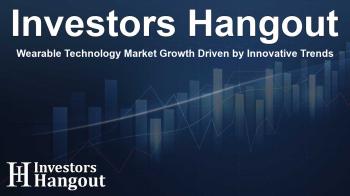Wearable Technology Market Growth Driven by Innovative Trends

Wearable Technology Market Dynamics
The wearable technology market is at the cusp of significant transformation, with an estimated growth of USD 99.4 billion projected from 2025 to 2029. This remarkable expansion is driven by a surge in demand for innovative devices such as smartwatches, fitness bands, and smart apparel. The growing popularity of these devices is largely influenced by their dual functionality as health monitors and payment methods, which enhances user experience and convenience.
Consumer Trends Shaping the Market
Smartwatches, fitness trackers, and IoT-based garments are evolving quickly, capturing the attention of a diverse consumer base that includes athletes, tech enthusiasts, and health-conscious individuals. These devices empower users with real-time health data, enabling them to monitor vital signs and track fitness levels efficiently. As wearable technology gains traction, people appreciate its practical applications in daily life, from managing workouts to improving health outcomes.
AI's Role in Market Evolution
Artificial intelligence (AI) is playing a pivotal role in reshaping the wearable technology landscape. From personalized suggestions based on user data to predictive analytics that help identify health risks, AI is set to revolutionize user experiences. The incorporation of advanced sensors and machine learning algorithms enhances device functionalities, leading to smarter wearables that cater to users’ unique needs.
Challenges Faced by the Wearable Technology Sector
Despite the optimistic outlook, the wearable technology market faces challenges, particularly from counterfeit products flooding the market. Renowned brands such as Apple and Samsung have been impacted by cheaper replicas that compromise quality and functionality. This not only affects brand reputation but also misleads consumers, making it vital for companies to reinforce their brand authenticity.
Market Segmentation and Opportunities
The wearable technology market encompasses various product segments, including wrist-wear, eyewear, headwear, and IoT-integrated apparel. The rise in consumer electronics continues to push innovations in connectivity, such as Bluetooth and NFC, which are crucial for the seamless operation of wearable devices. Additionally, advancements in power-efficient batteries and sensors provide significant opportunities for product development.
Innovative Product Developments on the Horizon
With the rise of digital health technology, companies are investing heavily in R&D to create high-performance wearable devices. Smart clothing that monitors health metrics, augmented reality glasses, and fitness bands equipped with advanced tracking features are becoming commonplace. The integration of health and fitness functionalities into everyday wear is set to gain momentum as consumers seek convenience and connectivity in their devices.
Consumer Electronics and the Future
Consumer electronics play a critical role in the growth of the wearable technology market, with manufacturers continuously pushing the envelope on what’s possible. New product launches and collaborations between tech companies and fitness brands are frequent, focusing on integrating health monitoring solutions into user-friendly devices. Innovative features like gesture controls and fall detection systems for older adults exemplify how wearables are becoming increasingly relevant across various consumer demographics.
Conclusion: A Bright Future Ahead
The future of the wearable technology market is bright, marked by innovation and user-focused functionalities. As technology advances, the integration of AI and IoT into wearable devices will only deepen, leading to enhanced user experiences. With market growth metrics indicating a robust CAGR, companies are poised to explore new frontiers in health, fitness, and everyday applications of wearable technology.
Frequently Asked Questions
What is driving the growth of the wearable technology market?
The growth is primarily driven by the increasing demand for smart wearable devices that offer functionalities such as fitness tracking, health monitoring, and payment capabilities.
How is AI impacting the wearable technology market?
AI enhances the capabilities of wearable devices by enabling personalized user experiences, predictive health monitoring, and more efficient data analytics.
What are some challenges faced by wearable technology companies?
Counterfeit products present a significant challenge by affecting consumer trust and brand integrity, complicating market dynamics for established brands.
What types of products are included in the wearable technology market?
The market includes wrist-wear (like smartwatches), eyewear (such as AR glasses), and IoT-enabled clothing, among others.
How is the integration of consumer electronics influencing wearable technology?
Advancements in consumer electronics, particularly in connectivity and sensor technology, are crucial for enhancing the functionalities and performance of wearable devices.
About The Author
Contact Dominic Sanders privately here. Or send an email with ATTN: Dominic Sanders as the subject to contact@investorshangout.com.
About Investors Hangout
Investors Hangout is a leading online stock forum for financial discussion and learning, offering a wide range of free tools and resources. It draws in traders of all levels, who exchange market knowledge, investigate trading tactics, and keep an eye on industry developments in real time. Featuring financial articles, stock message boards, quotes, charts, company profiles, and live news updates. Through cooperative learning and a wealth of informational resources, it helps users from novices creating their first portfolios to experts honing their techniques. Join Investors Hangout today: https://investorshangout.com/
The content of this article is based on factual, publicly available information and does not represent legal, financial, or investment advice. Investors Hangout does not offer financial advice, and the author is not a licensed financial advisor. Consult a qualified advisor before making any financial or investment decisions based on this article. This article should not be considered advice to purchase, sell, or hold any securities or other investments. If any of the material provided here is inaccurate, please contact us for corrections.

